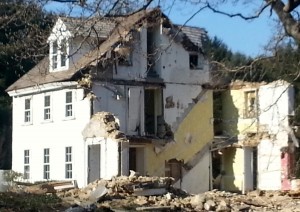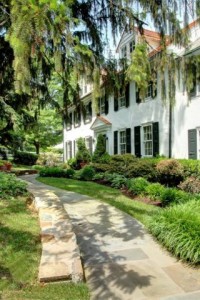With the recent demolition of the Ann Pugh Farm and as president of Tredyffrin Historic Preservation Trust, chair of the Annual Historic House Tour and owner of one of the oldest houses in the township, I feel a responsibility to speak out on the state of historic preservation in Tredyffrin Township .
After a review of the history of preservation in Tredyffrin and the demolition requirements, the following editorial was written and appears in this week’s Main Line Suburban newspaper and and online. As I say in the article, the people who purchased the 250-year old Ann Pugh house and then immediately demolished it did not break any laws. There were no ordinances in Tredyffrin Township to protect the 18th century house and there are no ordinances to protect the other 350+ historic properties in this community from a similar fate.
Preserving History Matters: Watershed Moment for Tredyffrin Township
Historic buildings play a special role in creating the distinctive character of each community. Historic preservation is about protecting, promoting, and using historic places. It is also about the power of place, places that matter because they help tell the story of our community, of who we are and where we come from. As suburban sprawl and roadside development make more and more places look the same, it becomes important for communities to keep their identities intact.
In January, we mourned the loss of the 18th century Ann Pugh house on Pugh Road in Wayne. The demolition of this beautifully restored historic treasure illustrates the plight of America’s old homes. Historic homes are on demolition lists all over America but many of us hoped that it would never happen in Tredyffrin. As president of Tredyffrin Historic Preservation Trust, whose mission is to “preserve and protect historic and cultural resources in Tredyffrin Township”, chair of the Annual Historic House Tour and owner of one of the oldest houses in the Township, I feel it is my duty to speak out.
Typically, historic houses that have been badly neglected over the years, and are in such a state of disrepair that they are considered eyesores, are the ones targeted for demolition. However, the Ann Pugh house was neither neglected or in a state of disrepair. The stunning Georgian stone farmhouse on Pugh Road with its manicured landscaping and guest barn, springhouse and swimming pool had been meticulously restored and maintained. The real estate company described the Ann Pugh Farm as the “quintessential Pennsylvania farmhouse – a Main Line Classic”, a family home with five bedrooms, four bathrooms and five fireplaces.
The 2.2-acre property was sold on December 12, 2013 for $1.4 million; a demolition application followed two weeks later. According to township staff, the demolition application was approved within 48 hours of its submission with no notification to adjourning property owners required. Aside from the fact that the house demolished was historic, I found the lack of notification to neighbors concerning, especially given its location next to New Eagle Elementary School.
Mindful of private property rights, what can the township do, and what should it do (if anything) through its zoning and land use ordinances to stop the demolition of historic buildings? The issue of historic building regulation, and land use regulations, versus the rights of individual property owners has seen much debate over the years in Tredyffrin with little agreement.
Although preservation issues facing Tredyffrin Township are similar to those faced by other communities, it is interesting that municipalities like Willistown, Lower Merion and Radnor have managed to balance the rights of individual property owners with the protection of historic properties. For instance, in Lower Merion, a demolition permit for a property on their Historic Resource Inventory list requires the recommendation of their Historic Commission plus approval from the Board of Commissioners. The demolition process requires similar review in Willistown and Radnor townships. No such requirement for review of demolition applications exists in Tredyffrin Township. No ordinance protects the demolition of any historic building nor does a demolition permit require the review of any township board or commission or the approval of the Board of Supervisors.
Since its founding by Welsh settlers in 1707, Tredyffrin Township has enjoyed a rich inventory of historic resources. In the 1960’s Tredyffrin Township was the first municipality in Pennsylvania to establish a Historic Architectural Review Board (HARB) and they had authority over a Historic Site List of 29 historic properties. Unlike the conventional historic society, the HARB is a regulatory body with the legal authority to recommend approval to the Board of Supervisors for building permit applications that involved the reconstruction, alteration or demolition of these 29 properties. Some of the historic properties on the list included the one-room Diamond Rock Octagonal School, Old Eagle School, Great Valley Mill, Wharton Esherick Museum, Baptist Church in the Great Valley, Lee & Bradford Quarters (Picket Post Swim Club), Van Leer Cabin next to Conestoga HS, Strafford Train Station)
In 2003, an award-winning Historic Resource Survey, recognized by the Pennsylvania Historic Museum Commission, was completed for the Township. The study provided a detailed inventory of 356 important historic resources in the Township. A database and Geographical Information System (GIS) were included to link the historic resources to the Township’s existing GIS tax parcel data.
The survey listed and classified historic properties into three categories – Class I, Class II, and Class III. The recently demolished Ann Pugh house was listed as a Class II property in the Township survey with an additional recommendation for potential listing on the National Register of Historic Places. As an aside, National Historic Register properties are not protected from demolition in Tredyffrin Township. The Federal government recognizes historically and architecturally important properties but leaves their regulation to local municipal government.
After the completion of the Historic Resource Survey in 2003 and the updated Comprehensive Plan and Historic Preservation Plan in 2009, there was discussion about adding historic properties to the list of 29 protected properties. It was determined that the easiest way to add to the list would be to replace the HARB with a Historical Commission which occurred in June 2011. Unfortunately, a list of protected properties in Tredyffrin Township no longer exists and the protection for the original 29 properties is gone.
Over a decade ago, Tredyffrin Township’s elected officials acknowledged the importance of our historic buildings, hired a consulting company to catalogue, and document them for the Historic Resource Survey. However, other than receiving accolades from Harrisburg … nothing further was done with the survey results. If the Township had used the Historic Resource Survey as a tool to protect historic properties, the Ann Pugh house would probably still be standing.
Tredyffrin Township is always mentioned when discussing Philadelphia’s Main Line historic suburbs. In fact, the Township has the distinction of the highest number of historic properties of all municipalities in Chester County. Seven years ago, the Township celebrated its first three hundred years of history (Tredyffrin 300), the same year that it received Preserve America designation for “protecting and celebrating its heritage”.
For historic preservationists, the destruction of any historic property is difficult but is compounded when it occurs in your own backyard. What makes Tredyffrin Township truly unique is its rich architectural heritage: the old homes and buildings that tell the story of the community’s past, that continue to bring pleasure in the present, and will, if properly cared for, inform and inspire the future.
To be clear, the people who purchased the 250-year old Ann Pugh house and then immediately demolished it did not break any laws. There were no ordinances in Tredyffrin Township to protect the 18th century house and there are no ordinances to protect the other 350+ historic properties in this community from a similar fate.
For historic preservation to matter, and for our local history to be meaningful, it needs to be supported. A watershed moment for historic preservation in Tredyffrin Township, will the loss of the Ann Pugh house serve as the needed impetus for change. Or, will it send the message that Tredyffrin Township values individual property rights and development at all costs and allow the destruction of our historic buildings to continue.
We understand that change will occur as the future unfolds, but this does not have to happen at the expense of our community’s historic properties. A community that respects its history respects itself.
Pattye Benson
President, Tredyffrin Historic Preservation Trust
Chair, Annual Historic House Tour


I totally agree with you on this. Keep up the pressure on the Supervisors to do what is right. I am deeply saddened by the actions taken by the new owners — even if they did not break any laws. It is yet another example of what is wrong with our culture these days, Total disregard to history — it is now all about me. I would ask — why did they buy property — plenty of plots that size in the township — why this one??
Thank you for a thoughtful and carefully considered editorial.
Has anybody reached out to the buyers to ask them why they razed the house? Seems like there is a lot of speculation here. Would be good to know, assuming of course they would be willing to share their reasoning.
Pattye:
About five years ago I was involved with structures on the National Register of Historic Homes, specifically to determine if one can be demolished or modified with modern doors and windows. West Whiteland’s Historic Preservation Board said no on both counts; however, in subsequent research I came to the conclusion that both demolition and renovation could be done without incurring any penalties. Permits were required, of course. Also, that the Historic Pres. Brd. is only an advisory board. This leads me to the conclusion that a township can create a culture of preservation among its residents and the board of supervisors–good ideas, and make the destruction and renovation permitting process laborius, but in the end, can’t prevent or penalize an owner from doing so. (I’m not a developer or builder, or interested in destroying an historic structure.)
I have dear friend who has a historic home in Society Hill in Philadelphia. She has to get approval to have any exterior work done on her home.
Philadelphia may have many issues but when it comes to historic preservation, they have something to teach Tredyffrin Township.
So glad this matter is getting reviewed.